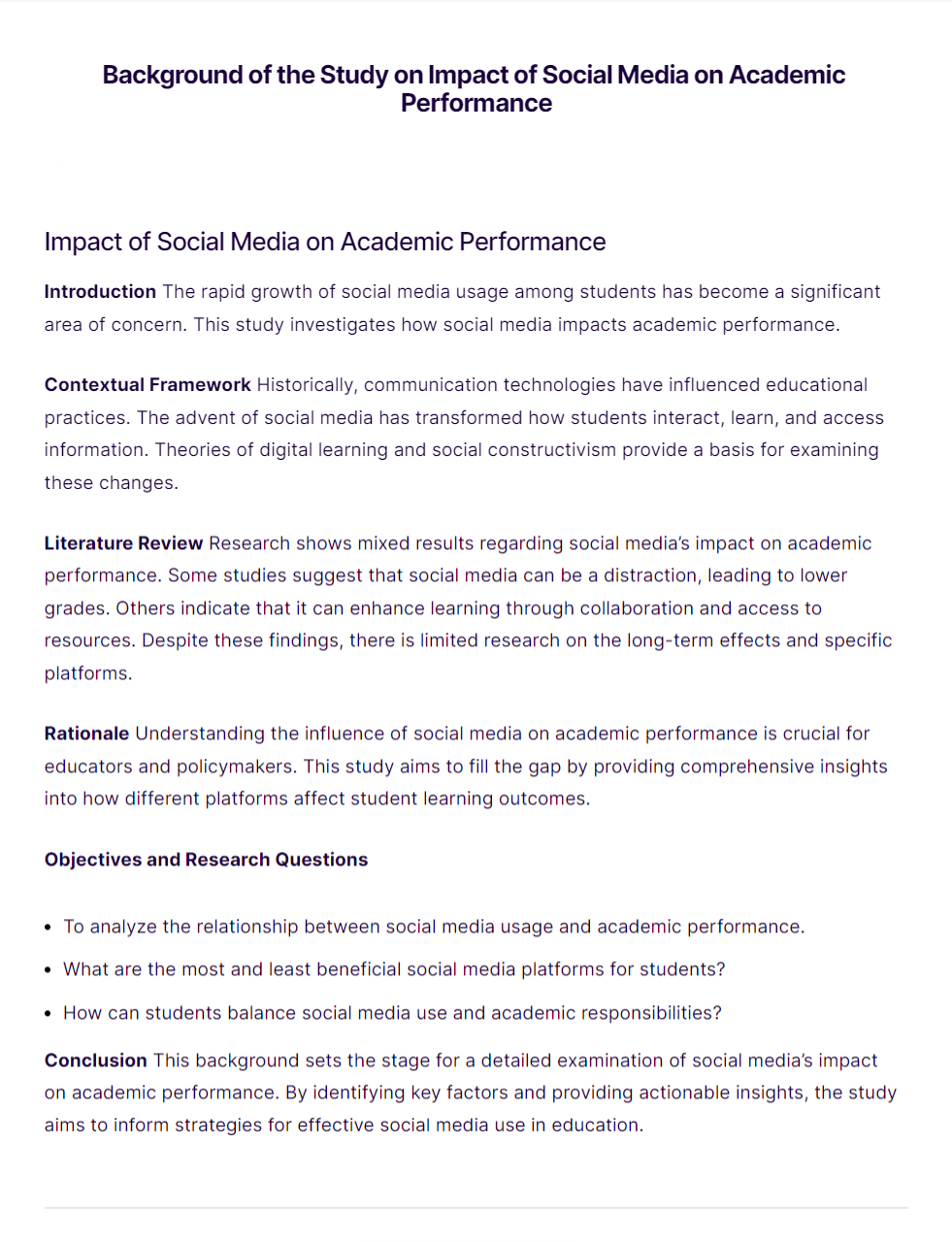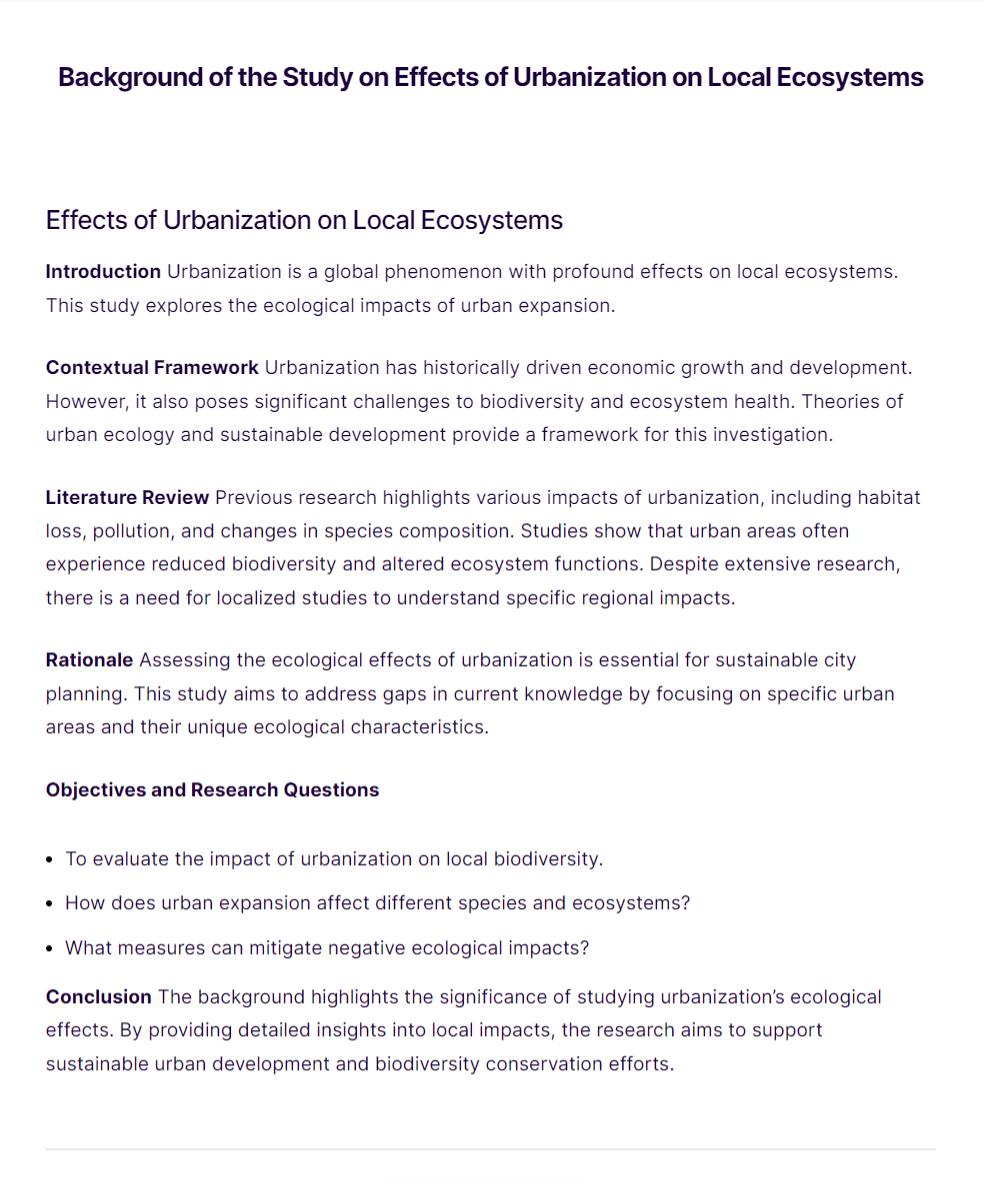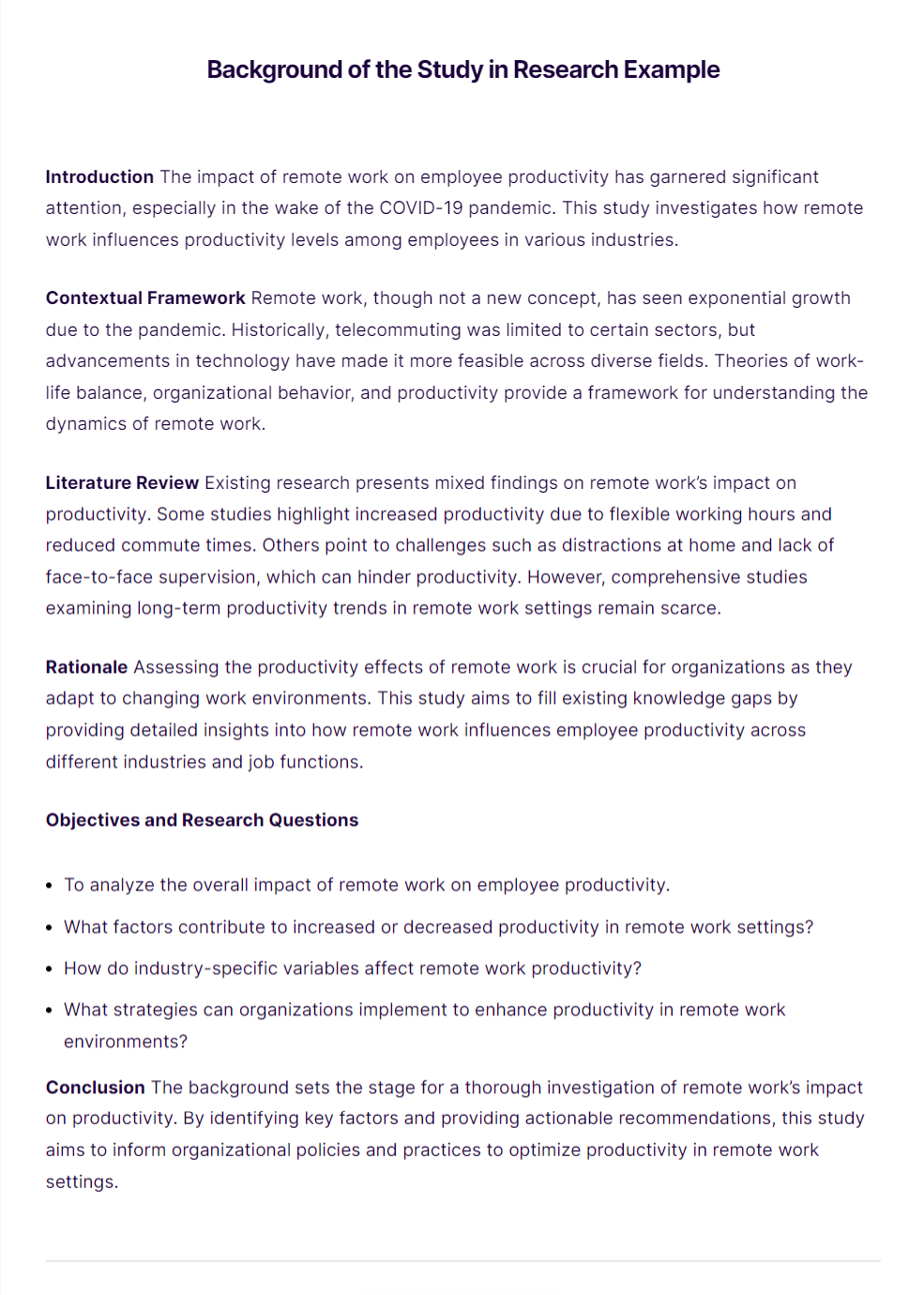10+ Background of the Study Examples to Download
The background of the study provides a comprehensive overview of the research problem, including the context, significance, and gaps in existing knowledge. It sets the stage for the research by outlining the historical, theoretical, and practical aspects that have led to the current investigation, highlighting the importance of addressing the identified issues.
What is the Background of a Study?
The background of a study provides context by explaining the research problem, highlighting gaps in existing knowledge, and establishing the study’s significance. It sets the stage for the research objective, offering a foundation for understanding the study’s purpose and relevance within the broader academic discourse.
Background of the Study Format
The background of the study is a foundational section in any research paper or thesis. Here is a structured format to follow:
1. Introduction
- Briefly introduce the topic and its relevance.
- Mention the research problem or question.
2. Contextual Framework
- Provide historical background.
- Discuss relevant theories and models.
- Explain the practical context.
3. Literature Review
- Summarize key studies related to the topic.
- Highlight significant findings and their implications.
- Identify gaps in the existing literature.
4. Rationale
- Explain why the study is necessary.
- Discuss the significance and potential impact.
- Justify the research focus and scope.
5. Objectives and Research Questions
- State the primary objective of the study.
- List the specific research questions.
6. Conclusion
- Summarize the importance of the background.
- Emphasize how it sets the stage for the research.
Sample:
Introduction The increasing incidence of climate change and its effects on global agriculture has raised significant concerns among researchers. This study focuses on the impact of climate change on crop yields.
Contextual Framework Historically, agricultural practices have adapted to gradual climate changes. However, recent rapid shifts have outpaced these adaptations, necessitating urgent research. Theoretical models of climate adaptation provide a foundation for understanding these changes.
Literature Review Recent studies show mixed results on the extent of climate change impacts on agriculture. While some regions experience reduced yields, others report minimal changes. These discrepancies highlight the need for a focused study on regional impacts.
Rationale This research is crucial for developing strategies to mitigate adverse effects on agriculture. Understanding specific regional impacts can help tailor interventions, making this study highly significant for policymakers and farmers.
Objectives and Research Questions
- To assess the impact of climate change on crop yields in the Midwest.
- What are the main climate factors affecting agriculture in this region?
- How can farmers adapt to these changes effectively?
Conclusion The background of the study underscores its relevance and importance, providing a solid foundation for the research. By addressing identified gaps, this study aims to contribute valuable insights into climate change adaptation strategies in agriculture.
Background of the Study Examples
- Impact of Social Media on Academic Performance
- Effects of Urbanization on Local Ecosystems
- Role of Nutrition in Early Childhood Development
Impact of Social Media on Academic Performance

Effects of Urbanization on Local Ecosystems

Role of Nutrition in Early Childhood Development

More Background of the Study Examples
- Online Learning and Reading Skills
- Mindfulness at Work
- Parental Role in Preventing Childhood Obesity
- Green Building and Energy Efficiency
- Peer Tutoring in High Schools
- Remote Work and Work-Life Balance
- Technology in Healthcare
Background of the Study in Research Example

Background of the Study in Qualitative Research Example

Importance of Background of the Study
The background of the study is essential for several reasons:
- Context Establishment: It sets the stage for the research by outlining the historical, theoretical, and practical contexts.
- Literature Review: It provides a summary of existing literature, highlighting what is already known and identifying gaps in knowledge.
- Research Justification: It explains why the study is necessary, showcasing its relevance and significance.
- Research Direction: It guides the research questions and objectives, ensuring the study is focused and coherent.
- Foundation for Methodology: It lays the groundwork for the research methodology, explaining the choice of methods and approaches.
- Informing Stakeholders: It helps stakeholders understand the importance and potential impact of the research.
How is the Background of a Study Different From the Introduction?
The background of a study and the introduction serve distinct but complementary purposes in a research paper. Here’s how they differ:
Background of the Study
- Purpose:
- Provides detailed context for the research problem.
- Explains the historical, theoretical, and practical background of the topic.
- Identifies gaps in existing knowledge that the study aims to fill.
- Content:
- Includes a comprehensive literature review.
- Discusses relevant theories, models, and previous research findings.
- Sets the stage for the study by explaining why it is important and necessary.
- Length and Detail:
- Typically more detailed and longer than the introduction.
- Provides in-depth information to help readers understand the broader context of the research.
Introduction
- Purpose:
- Introduces the topic and the research problem in a concise manner.
- Captures the reader’s interest and sets the stage for the rest of the paper.
- States the research objectives, questions, and sometimes hypotheses.
- Content:
- Brief overview of the topic and its significance.
- Clear statement of the research problem.
- Outline of the study’s objectives and research questions.
- May include a brief mention of the methodology and scope.
- Length and Detail:
- Typically shorter and more succinct than the background.
- Provides a snapshot of what the study is about without going into detailed literature review or theoretical background.
Example to Illustrate the Difference
Introduction Example: The rapid growth of social media usage among students has raised concerns about its impact on academic performance. This study aims to investigate how social media influences students’ grades and study habits. By examining different platforms and usage patterns, the research seeks to provide insights into whether social media acts as a distraction or a beneficial tool for learning.
Background of the Study Example: Social media has transformed communication and information sharing, particularly among young people. Historically, educational environments have seen various technological impacts, from the introduction of computers to the widespread use of the internet. Theories of digital learning suggest both positive and negative effects of technology on education. Previous studies have shown mixed results; some indicate that social media can enhance collaborative learning and resource access, while others point to decreased academic performance due to distraction. Despite these findings, there is limited research on the long-term effects of specific social media platforms on academic outcomes. This study addresses these gaps by exploring how different types of social media usage impact student performance, aiming to provide a nuanced understanding of this contemporary issue.
Where is the Background of a Study Placed in a Research Paper?
The background of a study is typically placed within the Introduction section of a research paper, but it can also be a separate section immediately following the introduction. Here’s a more detailed breakdown of where the background of the study can be placed:
Within the Introduction
- Integrated into the Introduction:
- In many research papers, the background of the study is woven into the introduction. It provides context and justification for the research problem, leading up to the statement of the research objectives and questions.
- Flow of Content:
- Starts with a general introduction to the topic.
- Provides background information and context.
- Reviews relevant literature and identifies gaps.
- States the research problem, objectives, and questions.
As a Separate Section
- Following the Introduction:
- In more detailed or longer research papers, the background of the study can be a standalone section that comes immediately after the introduction. This allows for a more comprehensive presentation of the context, literature review, and theoretical framework.
- Structure:
- Introduction: Briefly introduces the topic and states the research problem.
- Background of the Study: Provides detailed context, literature review, theoretical background, and justification for the research.
- Research Objectives and Questions: Clearly states the aims and specific questions the research seeks to answer.
How to Write a Background of the Study

Writing a background of the study involves providing a comprehensive overview of the research problem, context, and significance. Here’s a step-by-step guide on how to write an effective background of the study:
Introduce the Topic
Begin with a General Introduction: Start by introducing the broad topic to give readers an overview of the field.
Example: “Social media has revolutionized communication and information sharing in the digital age.”Provide Context
Historical Background: Explain the historical development of the topic.
Example: “Historically, communication technologies have significantly influenced educational practices, from the introduction of the internet to the advent of mobile learning.”
Theoretical Framework: Mention relevant theories and models.
Example: “Theories such as social constructivism and digital learning provide a basis for understanding how students interact and learn through social media.”Review Relevant Literature
Summarize Key Studies: Provide a summary of significant studies related to your topic.
Example: “Previous research has shown mixed results regarding the impact of social media on academic performance. Some studies suggest that social media can be a distraction, leading to lower grades, while others indicate it can enhance learning through collaboration.”
Identify Gaps in Knowledge: Highlight gaps or inconsistencies in the existing literature.
Example: “Despite extensive research, there is limited understanding of the long-term effects of specific social media platforms on student performance.”Explain the Rationale
Justify the Need for the Study: Explain why your study is necessary and important.
Example: “Assessing the impact of social media on academic performance is crucial for developing effective educational strategies and policies. This study aims to fill the existing knowledge gaps by providing detailed insights into how different platforms affect student learning outcomes.”State the Research Objectives and Questions
List the Objectives: Clearly state the main objectives of your study.
Example: “The primary objectives of this study are to analyze the relationship between social media usage and academic performance and to identify the most and least beneficial platforms for students.”
Pose Research Questions: Include specific research questions that guide your study.
Example: “What are the main factors influencing the impact of social media on academic performance? How can students balance social media use and academic responsibilities?”Conclude with the Importance of the Study
Summarize the Significance: Emphasize how your study will contribute to the field.
Example: “This study’s findings will provide valuable insights into the role of social media in education, informing educators and policymakers on how to leverage these tools effectively to enhance student learning outcomes.”
How to avoid mistakes in writing the Background of a Study
Avoiding mistakes in writing the background of a study involves careful planning, thorough research, and attention to detail. Here are some tips to help you avoid common mistakes:
1. Lack of Clarity and Focus
- Clearly define the research problem and stay focused on it throughout the background section. Avoid going off on tangents.
- Example: If your research is about the impact of social media on student performance, don’t delve into unrelated topics like general internet usage unless directly relevant.
2. Insufficient Literature Review
- Conduct a comprehensive literature review to cover all relevant studies and theories. This helps to establish the context and identify gaps in existing knowledge.
- Example: Use databases like Google Scholar, PubMed, or your institution’s library to find peer-reviewed articles and credible sources.
3. Overwhelming with Too Much Information
- Be concise and selective with the information you include. Focus on the most relevant studies and findings that directly relate to your research problem.
- Example: Summarize key studies and avoid detailed descriptions of every study you come across.
4. Failure to Identify Gaps in Knowledge
- Clearly highlight the gaps or inconsistencies in the existing literature that your study aims to address.
- Example: “While several studies have explored social media’s impact on general communication skills, few have examined its specific effects on academic performance among high school students.”
5. Lack of Theoretical Framework
- Include relevant theories and models that provide a framework for your study. This helps to ground your research in existing knowledge and gives it a theoretical basis.
- Example: “The study is grounded in social constructivism, which suggests that learning occurs through social interactions, making it relevant to examine how social media platforms facilitate these interactions.”
6. Inadequate Justification for the Study
- Clearly explain why your study is important and necessary. Provide a strong rationale for why the research problem needs to be addressed.
- Example: “Understanding the impact of social media on academic performance is crucial for developing effective educational strategies and policies.”
7. Poor Organization and Structure
- Organize the background section logically. Use subheadings to break down different parts, such as introduction, literature review, theoretical framework, and rationale.
- Example: Use clear headings like “Introduction,” “Contextual Framework,” “Literature Review,” “Rationale,” and “Research Objectives and Questions.”
8. Using Jargon and Complex Language
- Write in clear, simple language that is accessible to a broad audience. Avoid unnecessary jargon and technical terms.
- Example: Instead of “The pedagogical implications of digital media necessitate a paradigmatic shift,” say “Digital media impacts teaching methods, requiring changes in how we educate.”
9. Ignoring the Research Objectives and Questions
- Always tie the background information back to your research objectives and questions. This ensures that your background is relevant and focused.
- Example: “This background review highlights the need to investigate how different social media platforms affect high school students’ study habits, directly addressing the research questions outlined.”
10. Neglecting to Update References
- Use the most recent and relevant studies to ensure your background is up-to-date. Check for the latest research developments in your field.
- Example: Instead of relying solely on sources from over a decade ago, incorporate recent studies that reflect current trends and findings.
What is the background of the study?
The background of the study provides context, explains the research problem, reviews relevant literature, and identifies gaps the study aims to fill.
Why is the background of the study important?
It establishes the context and significance of the research, justifies the study, and helps readers understand the broader academic landscape and gaps the research addresses.
How does the background of the study differ from the introduction?
The background provides detailed context and literature review, while the introduction briefly presents the research problem, objectives, and significance.
What should be included in the background of the study?
Include historical context, theoretical framework, literature review, gaps in knowledge, and the rationale for the study.
Where is the background of the study placed in a research paper?
It is typically integrated within the introduction or presented as a separate section following the introduction.
How long should the background of the study be?
The length varies, but it should be detailed enough to provide context and justification, typically a few paragraphs to several pages.
How do you write a strong background of the study?
Conduct thorough research, organize logically, include relevant theories and studies, identify gaps, and justify the research’s importance.
Can the background of the study include preliminary data?
Yes, including preliminary data can strengthen the background by demonstrating initial findings and supporting the research rationale.
How do you identify gaps in the literature?
Conduct a comprehensive literature review, compare findings, and note inconsistencies, unexplored areas, or outdated research that your study will address.
Should the background of the study be written in chronological order?
Not necessarily. Organize logically by themes, concepts, or research gaps rather than strictly chronologically to provide a coherent context for your study.



